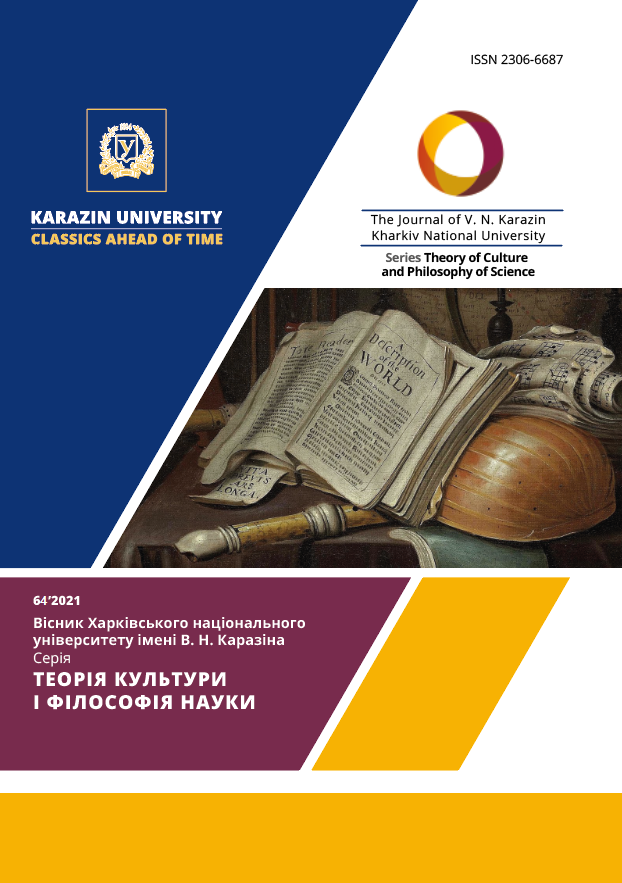CINEMATOGRAPHY AS A DESCRIPTIVE PHILOSOPHY "ON THE CINEFILM" OF IMAGES OF HOMO: FROM THE FIXATION OF IMAGES (HOMO PHOTOGRAPHICUS) TO THE TREACHERY OF IMAGES (CONTEMPORARY HOMO VIDENS)
Abstract
The article explores art of cinematography as an objectified cultural reality, in spatial and temporal structures of video description. Genesis of art of photography has changed the habits of human perception and thinking process – from photographic images of Homo photographicus to contemporary Homo Videns whose visual experience is the experience of appropriation and distancing from the world in its optical modality. The art of cinematography, correlating with metaphysical discourses of reality, creates a socio‐cultural code as a matrix of meanings and senses. It provides organization and support to the semiotic fund of culture through performing the functions of socialization and cultural integration. The differences between video description and philosophical text are emphasized. The advantage of video description is being devoid of the complexity of philosophical texts due to readability of indexes, demonstration of codes that define their sequence through the captured images‐characters close to everyday life to the extent that they do not require any analysis as being self‐obvious.
The magic function of screen image is that it has multiple reflections, so narrative of identity is transferred to the outer plane, onto the other side of the screen when the image created by the operator is a signal that triggers imagination. The indicative character is transferred to the image, and these indicators are indexed sufficiently to be stimulus signs, effects for Homo Videns’s perception. They are deciphered according to the standards and ideals of a particular culture whose codes are recognized by the subject of that culture at a particular moment which influences constitution and re‐constitution of Homo Videns who consumes both things and images – but also transformation of culture itself. Technological transformation of images of Homo Videns is due to changes in the technology of filming and cinematography which is an important segment of cultural history. Even if cameraman's skills do not directly determine movement of technical progress, they dwell on the achievements of technological revolutions. The choice of problematic fields of human images analysis as bound with evolution of rendering techniques and visualizations, today is more justified than the rationalization of these images.
Downloads
References
Barker, J. M. (2009). The Tactile Eye: Touch and the Cinematic Experience. Berkeley, Los Angeles: University of California Press.
Barthes, R. (2015). The Third Meaning. Moscow: Ad Marginem. (In Russian).
Benjamin, W. (1996). A brief history of photography. In The Work of Art in the Age of Its Technical Reproducibility. Moscow. (In Russian).
Bordenyuk, S. (2020). Innovation of visual painting and cinematic thinking in the film “Two Days”. Kino‐Theater №3 (149). P. 38–41. (In Ukrainian).
Braudy L., Cohen M. Film Theory and Criticism: Introductory Readings. Oxford: Oxford University Press. 2009.
Bryukhovetska, L. (Ed.). (2020). Ukrainian Cinematography School. Selected: Collection of scientific articles. Kyiv: Kino‐Theater Magazine Editorial Board, Education of Ukraine. (In Ukrainian).
Carroll, N. (2008). Philosophy of Motion Pictures. Malden, MA: Blackwell.
Derrida, J. (2007). Positions (V. V. Bibikhin, Trans.). Moscow: Akademicheskiy proyekt. (In Russian).
Iampolski, M. (2008). Muratova. The experience of kinanthropology. Saint Petersburg: Seans. (In Russian).
Lapitsky, V. (2000). Writing and distinction: a first glance. In J. Derrida Writing and Difference. Saint Petersburg: Akademicheskiy proyekt. (In Russian).
Levicki, A. (2018). Tenth muse. Cinematography as a new art form. Eroticism in the cinema of the 19th – 20th centuries. Kharkiv: Gumanitarnyy Tsentr. (In Russian).
Manov, B. (2005). Technical characteristics and aesthetic nature of the image of the world (K. Razlogov, Trans). Kinovedcheskiye zapiski №71. P. 285. (In Russian).
McGowan T. (2007). The Real Gaze: Film Theory after Lacan. Albany: State University of New York Press.
Metz C. (1983). The Imaginary Signifier: Psychoanalysis and the Cinema/trans.by C. Britton, A. Williams, B. Brewster, A. Guzzetti, London and Basingstoke: The Macmillan Press LTD.
Metz, C. (2010). The Imaginary Signifier: Psychoanalysis and the Cinema (D. Ya. Kalugin, N. S. Movnina, Trans). Saint Petersburg. (In Russian).
Pashchenko, A. (2020). Toloka as an attempt at Ukrainian historiosophy. Kino‐Theater №4 (150) 2020. P. 10–11. (In Ukrainian).
Pauletto, S. (2004). Audiovisual Discourse in Digital Art, Available at: https://www.researchgate.net/publication/234802597_ Audiovisual_Discourse_in_Digital_Art 2004
Pisters P. (2003).The Matrix of Visual Culture: Working with Deleuze in Film Theory. Stanford: Stanford University Press.
Saint Anna has opened the Russian annual competition of student and debut films for national awards. (2008). ТТК №3. P. 34. (In Russian).
Schwab, M. (2000). Escape from the Image: Deleuze’s Image‐Ontology. In G. Flaxman (Ed.), The Brain Is the Screen: Deleuze and the Philosophy of Cinema (pp. 109‒139). Minneapolis: University of Minnesota Press.
Shvets, Yu. (2020). Cossack Christmas: do not believe, do not be afraid, do not ask. Kino‐Theater №3 (149). P. 3–4. (In Ukrainian).
Skuratovsky, V. (2020). Fellini’s structure of the frame (on his centenary). Kino‐Theater №3 (149) 2020. Р. 36–37. (In Ukrainian).
Skuratovsky, V. (2020). When and where was the moving image born? To the 125th anniversary of cinema. Kino‐Theater №4 (150) 2020. P. 43. (In Ukrainian).
Sontag, S. (1976). On photography. (In Russian).
Sontag, S. (1997). Against Interpretation. In Thought as passion. (In Russian). Moscow: Russian phenomenological society. (In Russian).
Van Lier, A. (2019). Philosophy of Photography (J. V. Shapoval, Trans.). Kharkiv: Gumanitarnyy Tsentr. (In Russian).
Voytyuk, I. (2020). Not a review at all. Kino‐Theater №4 (150) 2020. P. 12–14. (In Ukrainian).
Vyuzhanina, T. (2020). A close look at Stanley Kubrick’s “Eyes Wide Shut”. Kino‐Theater №2 (148) 2020. P. 28–29. (In Ukrainian).




